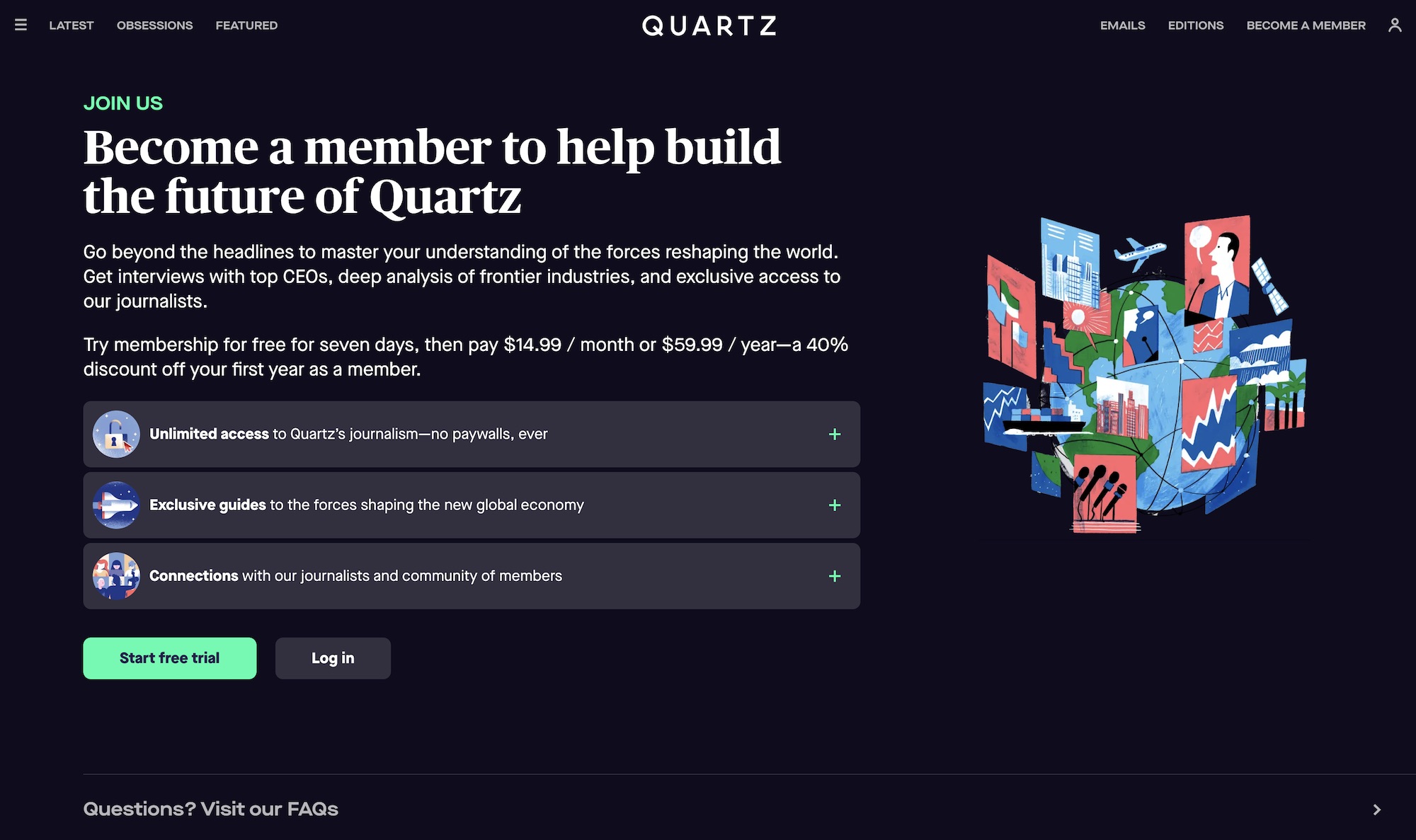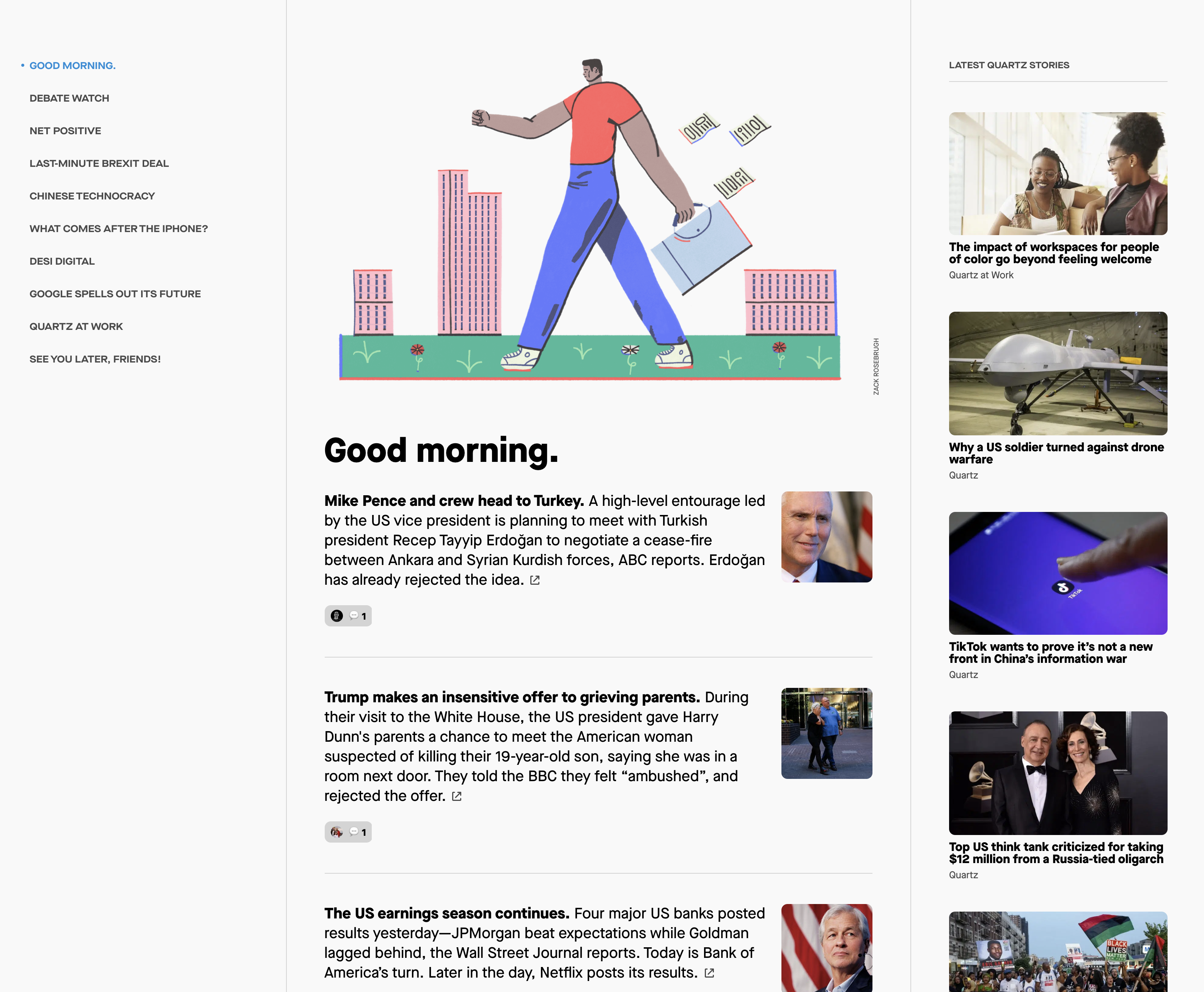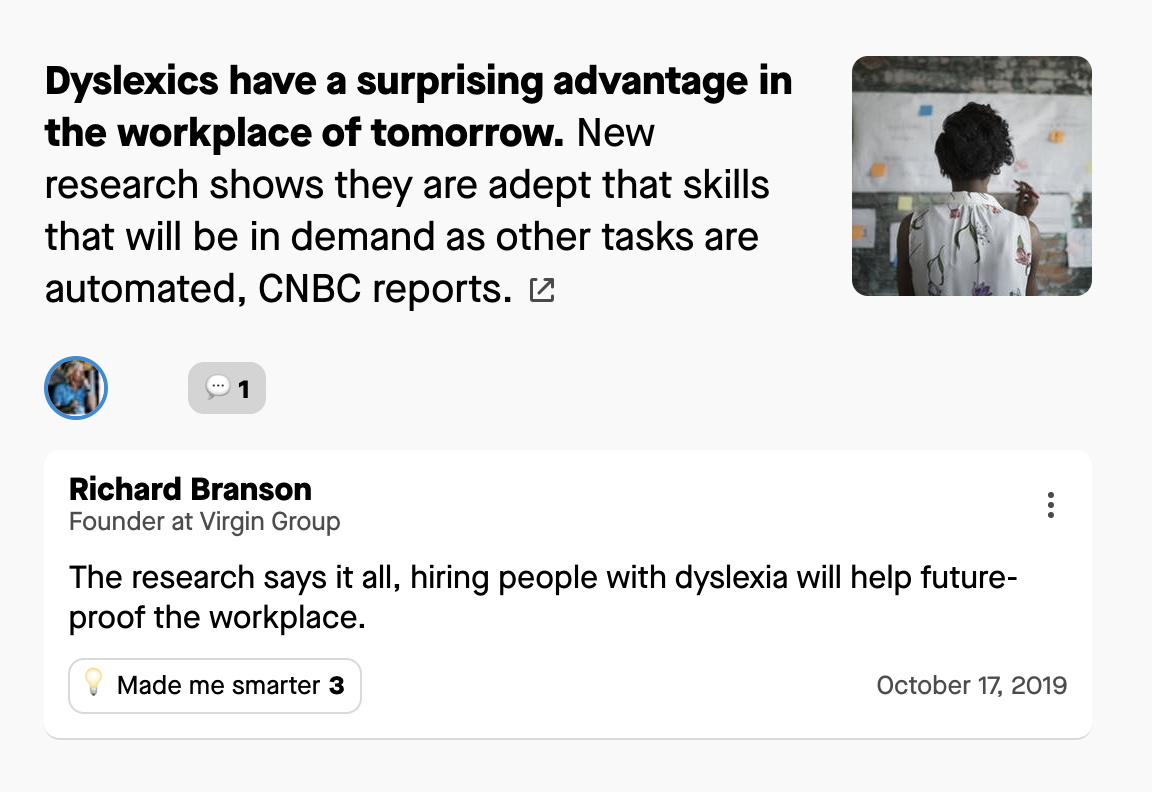
It has been a bumpy stretch for Quartz, one of the most lauded digital news startups of the past decade.
Not long after the Atlantic Media site was sold for $86 million to Japanese company Uzabase, web traffic started going in the wrong direction. Quartz says its monthly uniques were down 11 percent year over year between 2018 and 2019. Its membership program, launched nearly a year ago, didn’t seem to generating as much traction as desired. It put up a paywall in May after building its business on free distribution across all channels.
Then came last week. On Monday, anticipated leadership changes replaced co-CEOs Kevin Delaney and Jay Lauf with chief product officer Zach Seward (as CEO) and chief commercial officer Katie Weber (as president). The New York Times reported that Quartz lost more than $16 million on less than $12 million in revenue through the first half of 2019. On Wednesday, its iOS app was removed from the App Store in China after its reporting on the uprising in Hong Kong. And on Thursday, it debuted a new homepage and a refined, more member-focused vision of its future.
“The way I think about Quartz’s evolution is: We just turned seven years old and that’s 50 years in internet years. In that time Quartz has gone through several different eras of digital media,” said Seward, who, full disclosure, worked here at Nieman Lab a decade ago.
“There was this era at the beginning when it was considered smart and prescient to be mobile-first. Then there was the Facebook era where we and a whole lot of other digital publishers were able to really dramatically expand our audience and introduce our brands to the world on the backs of this distribution of social media. That era is clearly over. The way I would describe the new era we’ve entered is one where publishers are going to live or die based on their relationship with readers.”
Seward said Lauf and Delaney had decided to leave Quartz by early September, as 2020 budgeting and planning commenced. (Weber, Seward’s new leadership partner, is currently on parental leave. Lauf is staying on as chairman and Delaney will be an advisor.)
Quartz is far from the only outlet to be focusing more on members these days (reader revenue, reader revenue, reader revenue). One of the biggest questions is how to convince a reader to support your specific outlet over another in a world of finite personal budgets for journalism and broad competition. Especially since the biggest reader-revenue success stories (The New York Times, The Washington Post, The Wall Street Journal) are all broad general-interest publications that overlap in subject matter with, well, everyone at one time or another.
As a business publication with a global audience, this one is high on Quartz’s to-do list. There are any number of mainstream outlets reporting on Apple’s product prospects, Chinese tech, and the the future of work with their own prominent subscription offerings.The sticker price for Quartz’s membership program — $100 a year — is also higher than that of some of its non-newspaper peers, like The Atlantic ($50), New York ($50), Wired ($10), Vanity Fair ($15), and The Athletic ($60).
We’ve tracked many of Quartz’s strategies and changes since launch because the outlet has been an unusually bold innovator in the industry. Its Quartz Daily Brief was one of the first email newsletters to show the medium’s potential for media companies. At a time of mostly interchangeable mobile news apps, it built one entirely around a GIF-heavy chat interface. It’s invested in augmented reality, news-breaking bots, and an AI studio.
Throughout all those twists, though, the more revenue model was mostly unchanged: Quartz makes money from advertising — mostly high-quality, high-cost bespoke advertising for high-end brands (Prada! Infiniti! Credit Suisse! Boeing!). That model typically requires the kind of scale you get with relatively friction-free distribution — social-friendly, mobile-friendly, and outside any paywalls.
“Our revenue is still predominantly advertising, although within advertising there’s a lot of nuance to that business,” Seward said. “At this point, reader revenue — the membership business — accounts for a small percentage of our revenue. That’s precisely why we’re putting such a focus on it. Subscription businesses are a very different kind of business and the faster we can build up that business the more that will pay off in the long term.” He wouldn’t share any specific numbers [c’mon Zach, not even for Nieman Lab? —Ed.] but said they’re closely watching the total number of members and daily active users across Quartz’s email newsletters and apps. Uzabase financial filings say the company expects Quartz’s traditional ad-driven business to be profitable for the full year 2019 (anticipating the usual holidays bump in Q4), but that investments in the membership program will fuel that large expected overall loss.
Membership was a key part of Uzabase’s plans for Quartz; this was our Ken Doctor’s take on the sale last year:
At the core of this transaction: a lack of overlap and a promise of synergy. Quartz brings a big English-language audience and sophisticated ad selling and event marketing. Uzabase — emerging in Japan and more widely in Asia with both B2B and B2C business news products — opens up possibilities for faster Quartz expansion…
The move also clears the way for Quartz itself to move into the digital subscription space, a plan that has been awaiting execution as its audience grew. With its high-rate ad business, Lauf has told me the company wanted to move carefully as it added another leg of revenue. Now, it looks the time may be right.
Lauf told me today that the company had already accelerated its subscription plans earlier this year, before the sale became likely. Could Quartz offer a subscription product within 18 months. “Yes,” he said.
(It barely took four.)
While Quartz now has a traditional metered paywall, its membership offering is pitched differently than most outlets’ — more as an investment in the reader’s career, almost an educational product. Along with no paywall, it promises:
- in-depth field guides and shows about the most disruptive forces in business
- thought-provoking discussions with a diverse, global community of professional peers
- a direct relationship with our journalists on five continents
It’s meant to be a core part of the Quartz user experience rather than a premium-content add-on, Seward says. Quartz is focused on repackaging its journalism into longer-lasting resources for members like field guides and slide decks (it is a business audience, after all). That’s how he sees the outlet breaking out of the rest of the business reporting pack. “Quartz is best at is providing a guide to the global economy with a particular focus on how businesses and industries are changing,” he said.
For example: “Every week we produce a really deep dive on a company or industry or business trend that we’ve identified as really for you to understand if you want to understand the global economy. We’ve done nearly 50 of them at this point. Those are very unlike news coverage, in that all 50 of the news guides we’ve produced remain valuable today. As members you get access to all of it. In that sense it’s more similar to an Audible.com subscription, where you’re getting access to this huge library of journalism, than it is to a daily news subscription.” Members can also tune into conference calls with Quartz reporters digesting the issues or watch mini-documentaries about them.

Quartz has probably changed its homepage more than any other major digital outlet: It launched without a traditional homepage at all — you were thrown straight into the top story of the moment — launched without a homepage at all, later turned it into a web version of its morning Daily Brief email, and eventually an artier version of something more traditional.
Quartz’s new homepage looks less like a news site and more like a personal dashboard, greeting members by name with a time-appropriate “Good afternoon” and offering a briefing-like experience covering what Quartz sees as the top stories of the moment, usually grouped into larger topics. To emphasize its members, a selection of their comments appear right on the homepage itself underneath stories. (Members are usually identified by their titles; some highlighted on the homepage today include a “Futurist, Strategist, Philosopher,” someone “Spearheading the Transhumanist Movement,” and a “Founder at Virgin Group.” That would be Richard Branson.)


(It’s also being a bit more aggressive on pricing, offering a 40-percent-off coupon that lowers a new subscriber’s first-year price to $60.)
Quartz announced a key hire this morning, bringing Walt Frick (a former Knight Visiting Nieman Fellow here) aboard as membership editor, coming over from Harvard Business Review.
In the meantime, Quartz is also working on strengthening the journalism as well as broadening the perks. It recently launched its first-ever investigations team, which isn’t usually a short-term, small expense. John Keefe will lead the four-person reporting team digging into online advertising and political influence ahead of the U.S. presidential election, leaning on the grant-funded Quartz AI Studio to infuse more machine learning-powered reporting into the investigations. Seward said it wasn’t a hard choice as an investment:
“As we focus on membership and our relationship to members, a number one thing that members and potential members want from Quartz is our journalism. So it becomes a pretty easy calculus.”